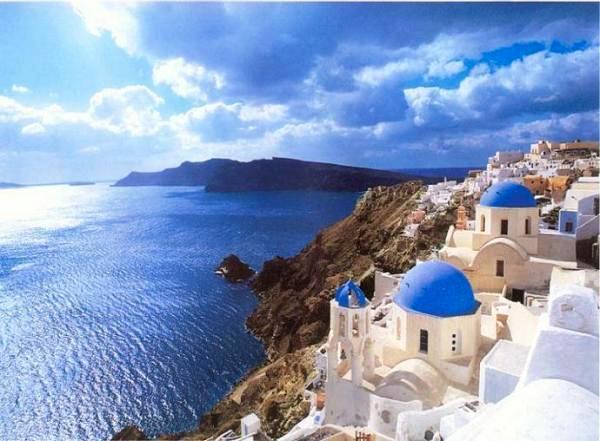The island of Santorini Greece or Thira is located in the Cyclades islands, in the middle of the Greek Islands of the Aegean Sea. Santorini is, along with Mykonos and Crete, the most famous holiday destinations in Greece. It is a small group of volcanic islands and its name refers to to Saint Irene. Called also Strongili and Kalisti, the island was the site of one of the largest volcanic eruptions in the world and what remains today is a submerged volcano and a caldera.
The island of Santorini is related to the myth of Atlantis, the amazing views from the villages of Fira, Oia perched on cliffs, santorinian sunset, the black and red beaches, the wine.

Beaches
The volcanic activity that shaped the archipelago left its mark on Santorini’s beaches as well. The southern half of Thira is speckled with multicolored sand overlooking the crystal clear waves of the Aegean Sea, and writers particularly like the black shores of Kamari and Perissa. For a change of scenery, take a westward drive to the fiery cliffs, red sand and sapphire water of the caldera in Akrotiri.
The festive beach towns of Perivolos and Perissa lie along an expansive 9km stretch of black sand on the southeastern coast, welcoming a more casual crowd of beach bums to its cheap bars and laid-back rooms for rent.
Archaeological Sites
Several thousand years ago, a volcanic eruption buried Santorini’s settlements under waves of molten lava. These towns were thought to be lost forever until archaeologists uncovered the remains of Ancient Akrotiri on the southwestern shore of Thira. While Ancient Akrotiri still remains one of Santorini’s most coveted experiences, a 2005 roof collapse at the excavation site has limited the number of visitors. Because the site is said to be closed until further notice, professional and leisure travelers suggest you check to see whether the site is open upon arriving in Santorini.
Tourists are also invited to wander the decrepit streets of Ancient Thira on Thira’s eastern coast, or learn about Santorini’s ancient civilizations at the Museum of Prehistoric Thira in Fira.
Shopping
Both Fira and Oia are filled with shops and boutiques selling jewelry, ceramics and leather goods for those willing to spend a pretty penny. Travelers with less extravagant tastes (and wallets) might be better served by the souvenir stores lining the beach in Kamari.
Nightlife
Night owls will most likely be disappointed by Santorini’s nightlife. Although there are several bars and clubs, writers say that options are limited. Because it’s the archipelago’s main city, Fira is home to the majority of Santorini’s nightlife venues, with bars and nightclubs located near the main square in the center of town. If you would prefer to have an evening on the beach, Kamari features numerous seaside bars and taverns.
The One Thing You Don’t Want to Miss
Santorini’s spectacular caldera is a vestige of what was probably the biggest volcanic eruption in recorded history, believed by some to have caused the disappearance of Atlantis. The island’s violent volcanic history is visible everywhere you look – in black-sand beaches, earthquake-damaged dwellings and raw cliffs of lava plunging into the sea.
Other Fun Things to Do
Volcanic eruptions have created beaches here unlike any you’ll see back home. The Red Sand Beach is one of the most beautiful sites to see. Bring your camera or simply experience and admire this stunning natural phenomenon.
Stop at a Santorini wine producer to enjoy a glass and explore the important role wine has served in the island’s growth.
Stroll through the scenic village Oia, a haven for artists and artisans, and explore their shops, enjoy a drink or a traditional dinner while watching the sun sink into the caldera.
Get a Taste of Local Flavor
Popular main dishes include mousakas (eggplant baked with minced meat and béchamel sauce), stuffed tomatoes and freshly grilled seafood. The mainstay of the Greek diet is the ubiquitous horiatiki salata (country salad), consisting of cucumber, tomatoes, onions, feta cheese and olives.
Local Currency
The Euro (EUR), the currency of the European Union, is the official currency of Greece. Many stores and restaurants also accept major credit cards, which usually offer you a good exchange rate. When shopping, remember there is a Value-Added Tax added to most purchases.

